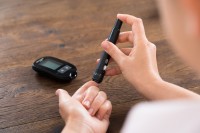- Home
- Dr Sultan Linjawi
Type 1 Diabetes
Type 2 Diabetes
Prediabetes
Gestational Diabetes
- Diabetes Information
- Testimonials
How is prediabetes treated?

What is prediabetes or borderline diabetes?
The way that diabetes is treated, depends on what type you have. There is also no one single treatment method! Blood glucose monitoring, insulin, and oral medications all play a role in treating diabetes. A healthy diet, maintaining a healthy weight, and enjoying regular physical activity, are all part of managing diabetes too. If you have type 1 diabetes and know someone with type 2 diabetes, you will likely be undergoing different treatment methods.
Prediabetes (borderline diabetes) explained simply
Prediabetes is a condition that describes a person who has a number of abnormal glucose blood tests suggesting they have borderline diabetes. It may also be called “impaired glucose tolerance” or “metabolic syndrome”. People with Prediabetes are very likely to progress to developing diabetes in the coming few years. More importantly, people with prediabetes are the most likely to recover and return back to normal by making a few important changes.
PreDiabetes Content |
|---|
| PreDiabetes Program |
| Overview |
| Risk Factors |
| Symptoms |
| Diagnosis |
| Complications |
| Treatment |
| Diet |
| Monitoring |
| Tools |
| Mental Health |
| Prevention |

DO YOU WANT TO GET YOUR DIABETES UNDER THE BEST CONTROL?
Click the program that best describes your situation.
What treatments are used in all types of diabetes?
While there are some differences between type 1 and type 2 diabetes treatments, there is also some overlap. Maintaining a healthy weight through a healthy diet and regular physical activity, is not only important in your diabetes treatment, but it is important for your overall health and well-being.
Healthy diet
You maybe have heard of a ‘diabetes diet’ but there is no specific diabetes diet! There are however, certain foods that you should prioritise over others. A healthy diet focuses on a wide variety of fruits and vegetables, wholegrains, lean proteins (i.e. red meat and fish), and low-fat dairy. These are foods that are packed with essential vitamins and minerals, and lower in fat and energy. Limiting the amount of saturated fats, refined carbohydrates (white bread and pasta), and sugary foods is also important. On the note of sugary foods, it is ok to have them sometimes, but they should be limited and treated as an occasional food item.
Understanding what food you can eat and in what quantities, can be difficult. It can take some time adjusting to a change in diet, even if they’re only small changes. Carbohydrate counting is a good option for people with diabetes, because it can help them to space their carbohydrate intake out across the day.
Physical activity
Regular exercise has great benefits for everyone, including people with diabetes! Exercise has the ability to lower your blood glucose levels by moving glucose into your cells where it’s used for energy. Exercising can also increase your sensitivity to insulin, meaning that your body needs less insulin to move glucose from the blood and into the cells.
Before you start exercising, you should talk to your doctor as they will be able to advise what level of intensity is best for you. If it’s been a little while since you’ve been to the gym, generally speaking, starting off with a morning or afternoon walk is a great way to slowly introduce yourself into exercising again. You can start my walking around the block and increase the distance of your walk little by little every day.
If you choose activities that you enjoy, or used to enjoy, it makes exercising far more exciting. Maybe you have a bike in the shed that is gathering a bit of dust, but you miss the feel of the wind blowing through your hair. Maybe you miss swimming when it’s really hot. Or maybe you’ve always wanted to take up salsa dancing. Whatever it is, finding an activity you like that can fit into your daily routine, will mean that you’re more likely to stick with it for the long haul.
When exercising, you should aim for at least 30 minutes or more of aerobic exercise on most days of the week. You could even break it up into three lots of 10 minutes and spread it across the day! Remember, it it’s been awhile since you were last active, start slowly and build gradually.
How is prediabetes treated?
Prediabetes treatment can take on many forms. Treatment primarily involves making lifestyle changes, monitoring blood glucose levels, and also taking diabetes medication, for example metformin.
Monitoring blood glucose levels
You may be checking and monitoring your blood glucose levels around four times per day. However, the number of times that you check your blood glucose levels can depend on recommendations from your endocrinologist or diabetes nurse. Careful and regular daily monitoring is the only way to ensure that your blood glucose levels remain within their target range. It can also tell you how well the changes that you are making are working. If they aren't, then you can keep adjusting till you find out what works best for you!
Although you might be managing your blood glucose levels well, they can still sometimes change unexpectedly for a number of reasons. They may change in response to food, physical activity, medications, illness, alcohol, and stress. If you’re a woman, changes in your hormone levels may also impact your blood glucose levels!
In addition to daily monitoring, you should be having a blood test every three months to check your HbA1c. HbA1c is a measure of your average blood glucose level over three months. HbA1c test is a good indicator for how well your diabetes treatment plans have been going overall. Your target levels may differ from someone else due to your age or what medications you may be taking to help with your diabetes management.
Metformin and prediabetes
Sometimes oral medications are given to people with diabetes too. Some of these medications can stimulate your pancreas to produce and release more insulin. While others inhibit the production and release of glucose from your liver, which means that you need less insulin. One of the most common medications is Metformin (which is covered in detail in the following article Starting on metformin. What you need to know). This is typically the first medication prescribed to people with type 2 diabetes.
Do you want to know more about Metformin?
Check out our articles for more content on metformin.
SGTL2 inhibitors and prediabetes
A new group of oral medications that are being used increasingly more commonly are called SGLT2 inhibitors. This class of drug works by blocking the reabsorption of glucose from the urine resulting in lots of glucose being lost from the body. This lowers blood sugar values and reduces the amount of insulin the body needs to produce to control a person's blood sugar. All good things. There are many variations of this drug including:
- canagliflozin (Invokana)
- dapagliflozin (Farxiga, Forxiga)
- empagliflozin (Jardiance)
- sotagliflozin (Zynquista)
- ertugliflozin (Steglatro)
These medications are covered in greater detail in the following article SGLT2 Inhibitors: What's the story?
What if I have gestational diabetes? How is gestational diabetes treated?
If you have gestational diabetes, controlling your blood glucose levels are essential not only for your own health, but also the health of your baby. In addition to maintaining a healthy diet and regular exercise, your treatment plan should also include regular blood glucose monitoring, and if required, insulin and oral medications.
For more about pregnancy and diabetes, please read:
- Metformin in pregnancy - Is it safe?
- Medication in pregnancy - safe or unsafe?
- Pregnancy diet and diabetes - preparing for pregnancy
- Gestational diabetes and diabetes in pregnancy.
- Diabetes and diet in pregnancy
Who is at risk of prediabetes?
Risk factors can be divided into non-modifiable risk factors and modifiable risk factors. Non-modifiable risk factors are those that can’t be changed by you, for example your genetics. Modifiable risk factors can be changed, for example making changes to the amount you exercise.
You are more likely to get prediabetes if you are carrying weight around your belly. It is much more common in people from certain ethnic backgrounds like Indian, Middle Eastern, south-east Asian and indigenous populations. In these groups rates of diabetes can approach 30% of the adult population. In Caucasian populations, the rates are more typically 10% of the adult population.
Non-modifiable risk factors in prediabetes?
Diabetes is much more common in people from certain ethnic backgrounds like Indian, Middle Eastern, south-east Asian and indigenous populations. In these groups rates of diabetes can approach 30% of the adult population. In Caucasian populations, the rates are more typically 10% of the adult population.
The non-modifiable risk factors which increase your chance of developing prediabetes include:
- Have a family history of diabetes
- Being older (over 55 years of age) – the risk increases as we age
- Ethnic background, including Aboriginal and Torres Strait Islanders, Pacific Islanders, Asian and South East Asian, African Americans, Native Hawaiians, and Hispanics/ Latinos
Being aware of the non-modifiable risk factors is extremely important. For people who have a family history of type 2 diabetes, you need to be more alert and start taking action early to prevent or delay prediabetes from developing into type 2 diabetes.
Modifiable risk factors in prediabetes
The modifiable risk factors which increase your chance of developing prediabetes include:
- Being overweight or obese, particularly extra weight around the waist
- Being physically inactive
- Eating a poor diet (one that is high in fat, salt, and sugar)
- High blood pressure
The 12 week Prediabetes program will help achieve this weight loss and reduce the risks of developing diabetes in the future. Explore our 12 week diabetes program.
What should I do next?
If you experience any symptoms of prediabetes or you have risk factors for developing prediabetes, it is important to get tested for as soon as possible. Some people are at higher risk and need regular testing. If you are 45 years or older or have other risk factors for prediabetes and type 2 diabetes, you will require more frequent testing. By diagnosing and treating the prediabetes early, it means you can decrease the risk of developing or delay any further health complications of prediabetes, for example nerve damage, blindness, and heart disease. It is important to know that diagnosing prediabetes should not rely solely on using a Hb A1c test.
Once you learn what your prediabetes status is, or if you already have prediabetes, the next most important step is to become educated. You can join the Personalised 12-week Prediabetes Program to help you learn how to prevent or delay prediabetes. The prediabetes program is personalised and tailored, giving you more of the content that you want. The program also helps you to stay motivated and teaches you what changes you need to make. The first week is free and full of helpful and crucial information.
If you would like to be a part of a supportive program, with easy to understand video content covering all aspects of diabetes, join our Personalised Prediabetes 12-week Program today! Don't forget, when you sign up, you receive the first week free!
Interested in more information on prediabetes?
Follow the links below to learn more about prediabetes.













